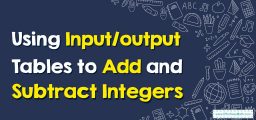How to Use Integers to Complete Equations
Untangling the enigmatic network of integers within equations can often be a thrilling pursuit, a journey that is characterized by precision, logic, and a dash of creativity. As we embark on this path to understanding the art of using integers to complete equations, we'll present a comprehensive, step-by-step guide that encompasses the multitudes of complexity embedded within this fascinating mathematical endeavor.

A Step-by-step Guide to Using Integers to Complete Equations
Here is a step-by-step guide to using integers to complete equations:
Step 1: Interpret the Equation
Begin your expedition by thoroughly interpreting the equation. Identify the unknown variables, the given integers, and the operations involved (addition, subtraction, multiplication, division, exponentiation, etc.).
Step 2: Assess the Nature of the Equation
Classify your equation based on its characteristics. Is it a linear equation with a single variable, a quadratic, a system of equations, or perhaps something else? This assessment will determine your subsequent strategy.
Step 3: Formulate a Strategy
After assessing the equation, determine your approach. If it’s a single-variable linear equation, simple isolation of the variable may suffice. For a quadratic equation, factoring, completing the square, or the quadratic formula might be necessary. For systems of equations, consider substitution, elimination, or matrix methods.
Step 4: Implement Your Strategy
Now that you’ve deciphered the equation and formulated a strategy, it’s time to get your hands dirty. Implement your approach step-by-step, ensuring to adhere to the rules of integer arithmetic and algebra.
Step 5: Check for Plausibility
Often, solving equations involving integers might lead to multiple solutions or no solutions. In such scenarios, it’s essential to check the plausibility of your answers within the context of the equation.
Step 6: Validate Your Solution
Once you’ve obtained a potential solution, it’s time to validate it. Substitute your solution back into the original equation and ensure both sides balance.
Step 7: Interpret the Solution
Finally, interpret your solution in the context of the problem. If it’s a standalone equation, your work may end with validation. However, if it’s part of a broader problem or real-world scenario, make sure to explain what the solution signifies.
Related to This Article
More math articles
- Top 5 Free Websites for OAR Math Preparation
- Quadrilaterals and Rectangles
- 10 Most Common 7th Grade IAR Math Questions
- Best Computers for Graphic Design in 2024
- 5th Grade ACT Aspire Math Practice Test Questions
- 4th Grade Georgia Milestones Assessment System Math FREE Sample Practice Questions
- Cofunction Identities
- Geometry Puzzle – Challenge 74
- How to Evaluate Recursive Formulas for Sequences
- Math anxiety is a common reality, yet the signs can be misinterpreted


























What people say about "How to Use Integers to Complete Equations - Effortless Math: We Help Students Learn to LOVE Mathematics"?
No one replied yet.